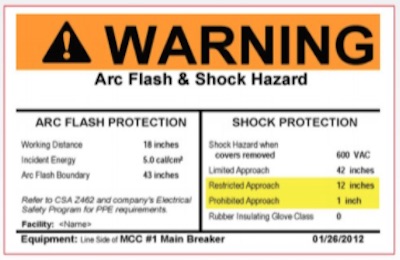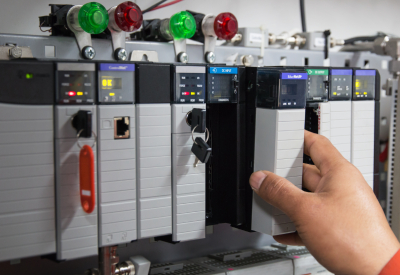Shock Risk Assessment and the Detailed Warning Label “Electrical Safety Zone”

June 4, 2018
By Len Cicero
Does this detailed warning label look familiar? Perhaps you have seen one, or at least one that resembles this in a commercial or industrial facility.
With all of the hype and conversation in recent years revolving around “arc flash,” it is likely due-time that we all start talking about shock, shock hazard and shock risk assessment.
Depending on how you break it down, there are about seven steps in the Canadian Electrical Code for completing a good shock risk assessment. Specific details are in the standard (2015 edition) but in Clause 4.3.4.1 “Shock risk assessment,” you will find three basic determinations:
1. Voltage to which personnel will be exposed
2. Boundary requirements
3. PPE necessary to minimize the possibility of electric shock
A competent and qualified electrical person can usually, and quite easily, determine the voltage(s) to which personnel could be exposed, when they know the work at hand.
As seen in the warning label, there are two boundary requirements in Z462-15 (the third boundary requirement — Prohibited — was removed from the 2015 version). Clause 4.3.4.3 gives specific details for the Limited Approach Boundary, which applies to approach by unqualified persons, working at or close to the Limited Approach Boundary, and entering the Limited Approach Boundary.
Having said all of this, what is actually meant by the “Limited and Restricted Approach Boundaries?” It can be referred to as the “Electrical Safety Zone” or “Safe Work Area.” The Limited Approach Boundary is the furthest of the two boundaries (within the electrical safety zone). Both, the limited approach, and the restricted approach, are dependent on the nominal system voltage in AC systems and the difference in potential in DC systems.
As many of us are aware when we troubleshoot or perform diagnostic work in a busy or high traffic area, it tends to draw an audience of spectators. Whether it’s asking questions or taking pictures, people’s curiosity can unintentionally put them in harms way. Something that we as tradespeople have allowed to happen for decades. This is where CSA Z462-15, and in particular the Limited Approach Boundary, comes in and lends us a hand. It must be stressed that the Limited Approach Boundary (Electrical Safety Zone) be established. Do not necessarily be focused on the exact distances prescribed in CSA Z462-15 or on the warning label. Be more focused on overseeing this work area and not permitting the spectators, including supervisors and managers, to gather around or encroach. CSA Z462-15 does allow an unqualified worker to cross the Limited Approach Boundary, however they must be escorted and briefed on the hazards by the qualified worker. In addition, by no means can an unqualified worker cross the Restricted Approach Boundary.
So, the next time you are performing diagnostics or troubleshooting in an open panel while energized, remember to establish a safe work area and ensure to keep the unqualified persons away and out of harms way.
Len Cicero is the owner and president of Lenco Training and Technical Services. He is a master electrician, and a certified electrical safety compliance professional. He is recognized by the industry, and his colleagues as a specialist in lockout and workplace electrical safety. Len is involved with CSA-460 as the technical committee chairperson, and is a founding and executive member of CSA-462. He is also a member of the Canadian Society of Safety Engineers and is the past president of the Halton Chapter of the Ontario Electrical League. For more information about Lenco Training and Technical Services, visit www.archflash.ca.
This article was reprinted with permission from Ontario Electrical League. It was first published in the Spring 2018 issue of OEL Dialogue; www.oel.org
















